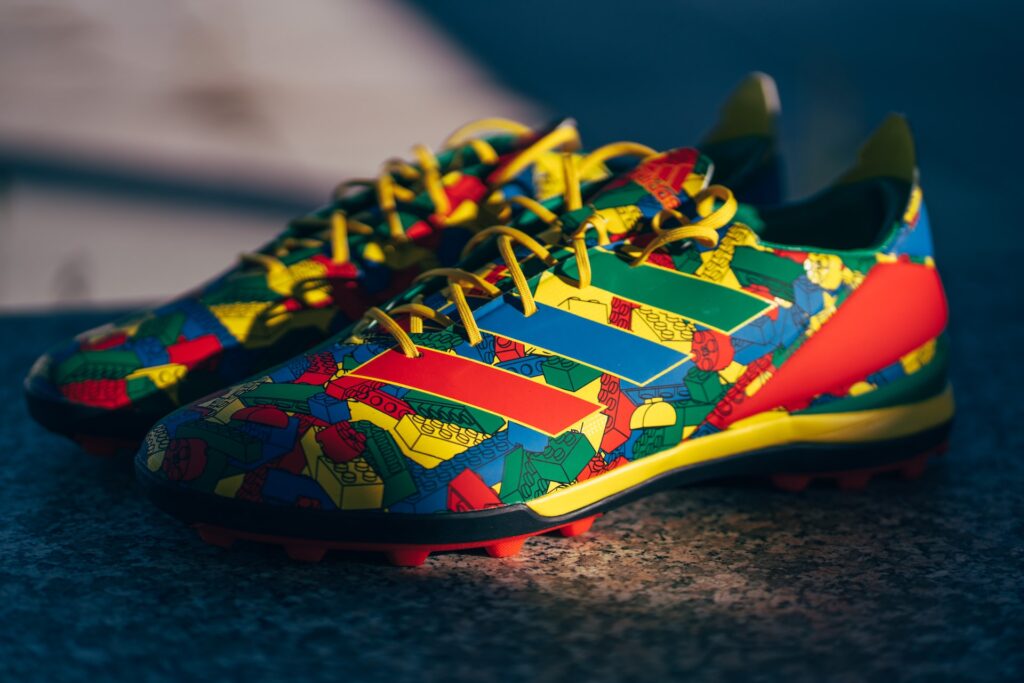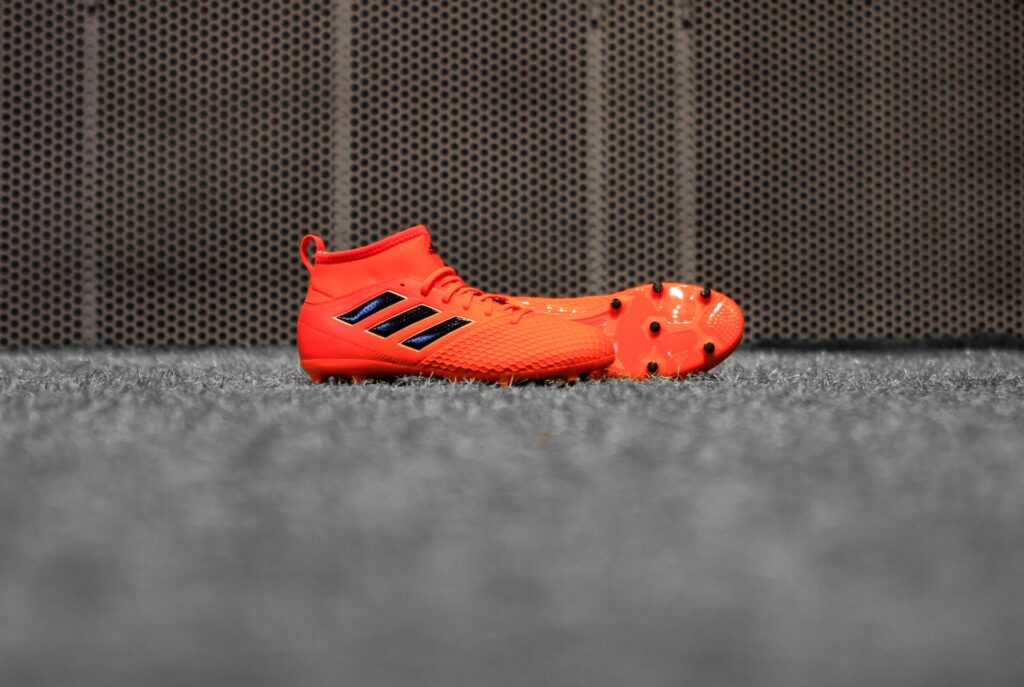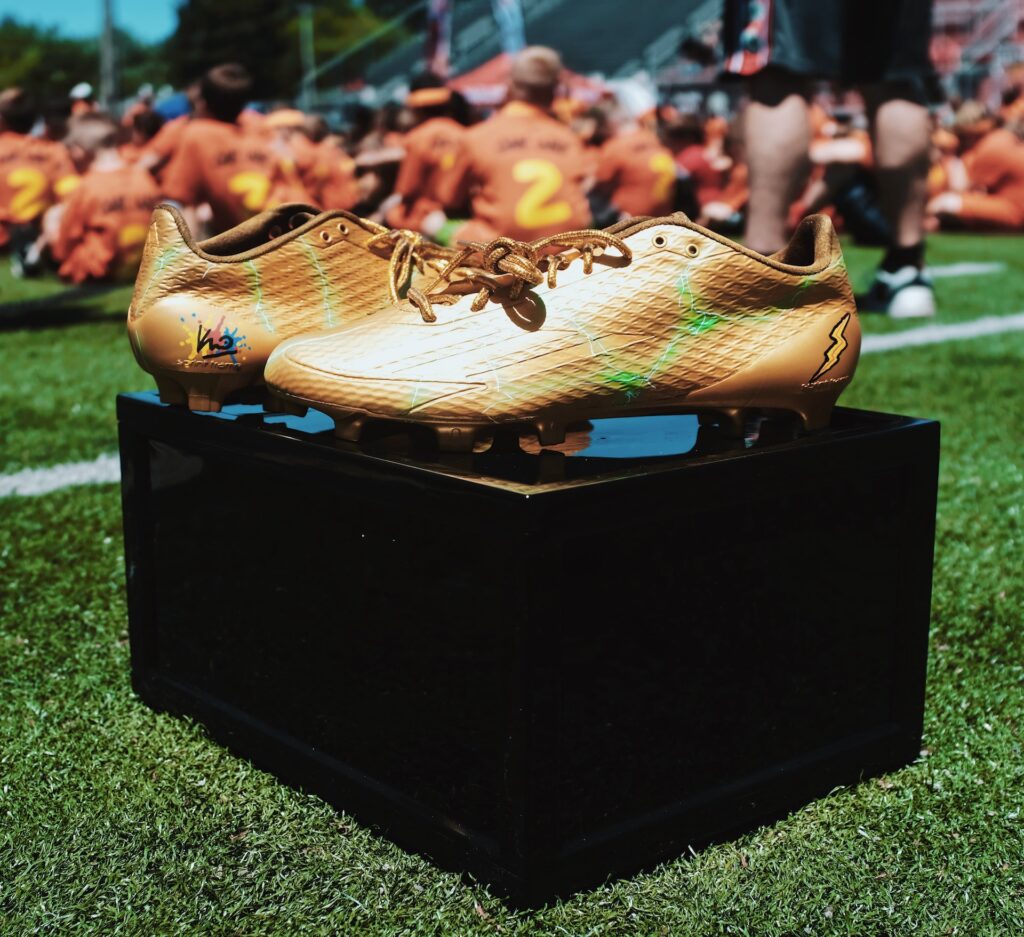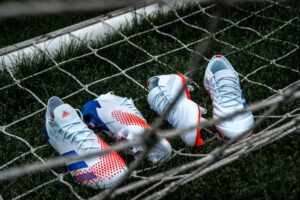Table of Contents
- Tip #1: Consider your buying options
- Tip #2: Think about brand
- Tip #3: Understand the different cleat types
- Tip #4: Consider the material
- Tip #5: Pick an ankle height
- Tip #6: Choose a color scheme
- Tip #7: Decide on a suitable fit and size
- Tip #8: Consider trying cleats on in store
- Tip #9: Know your return options
- Tip #10: Stick to your budget
- Tip #11: Break in your cleats
- Recap: Tips for buying soccer cleats
Welcome to this ultimate guide – the perfect place to find tips for buying soccer cleats online!
When I started playing soccer in the nineties, there wasn’t a huge deal of choice in terms of soccer cleats to choose from! Most cleats were black and white and were made by the likes of Adidas, Nike, and Umbro.
I remember my mum taking me to the local sports store to try on soccer cleats when I was growing at an alarming rate, and my choice was largely determined by comfort as opposed to brand.
However, things have changed a lot since the 1990s, and today’s soccer cleat market is burgeoning. There are so many things to think about when buying a pair of cleats, from the material to the color and design, making it difficult to know where to begin.
Having played soccer for the best part of thirty years, I know what to look for in a pair of soccer cleats. But if you’re ordering soccer cleats for the first time, I empathize with you as there’s so much to consider.
With that in mind, I introduce you to eleven tips for buying soccer cleats online that will help you choose the right pair of soccer cleats for you. Bear in mind that I’m not going to tell you which cleats are best for you, as I don’t know your preferences or budget.
So, without further ado, let’s dive into this ultimate guide to buying soccer cleats online to ensure that you have the ideal footwear to play soccer this season.
Tip #1: Consider your buying options
You don’t need me to tell you that there are so many online stores from which you can buy soccer cleats. You can buy soccer cleats directly from a manufacturer like Nike or Adidas, for instance, which can be a good way to see the latest trends and styles on offer.
But more commonly, people buy soccer cleats from retailers like Dick’s Sporting Goods, as it’s possible to choose from a wide range of brands, models, styles, and colors.
You can even order soccer cleats from Amazon if you do a lot of your online shopping through the retailer, but the selection is somewhat limited compared to sports retailers and manufacturers.
Of course, it’s entirely up to you where you decide to buy your soccer cleats from, but it’s good to know that you have a fair amount of choice when it comes to the retailer, and you don’t have to be too narrow with your search when looking for the best soccer cleats for you.
Tip #2: Think about brand
We all have our favorite brands in all walks of life, and soccer is no different. So many household names manufacture soccer cleats, and it can be difficult to pick one brand over another.
Frankly, you can buy soccer cleats from the likes of Adidas, Nike, Puma, Under Armour, Umbro, and so many other manufacturers. You can buy cleats directly from their online stores, or you can look to a third-party online retailer, which can be a good option if you’re not sure about which brand to go for from the outset.
When you’ve narrowed down your search to a few brands that you like, it makes it easier to refine your search by the parameters that I introduce below.
Tip #3: Understand the different cleat types

Perhaps the biggest decision you will need to make when you’re buying soccer cleats for the first time is which type of cleats are best suited to your preferences. Your choice will depend on the surface on which you’re planning to play soccer – be it real or fake grass, for instance.
Below are the different cleat types for you to think about, as well as a brief explanation of which surface they’re best suited to:
Soft ground
Perhaps the most common type of soccer cleat, soft ground studs provide traction when you’re playing soccer on wet and muddy surfaces. In most instances, soft-ground soccer cleats come with metal studs attached.
Firm ground
Cleats described as firm ground are those most commonly used for soccer games on a traditional grass surface, although some are also suitable for use on artificial turf. The studs on firm ground cleats are longer than molded studs.
Hard ground
Hard ground cleats feature round, molded studs and don’t dig into the ground for traction. Rather, they sit on top of the field or artificial surface and are only suitable when the pitch is dry and hard.
Indoor
At first glance, indoor soccer cleats look a lot like normal sneakers. But they tend to have a gripped sole that offers slightly more traction when playing soccer on a hard, indoor surface like a gymnasium court.
Turf cleats
Sometimes mistaken for firm ground cleats, turf (or astroturf) soccer shoes have small, dimpled studs that are perfect for use on astroturf and 3G pitches that are popular in small-sided soccer.
Depending on the surfaces on which you regularly play soccer, you might need to buy more than one pair of cleats. This is because most artificial surfaces aren’t suitable for soft ground cleats, while hard ground cleats will be as good as useless when you play soccer on a muddy field at the height of winter!
So, understanding the differences between cleat types is important, so you can equip your soccer bag with the appropriate equipment this season.
Tip #4: Consider the material
Not so long ago, the vast majority of soccer cleats were made from leather, and there wasn’t a great deal of choice in the matter. However, today, there are lots of different materials to consider for soccer cleats. Let’s look at some of the materials that you might consider for your cleats and why:
K-leather
Perhaps the best material for soccer cleats is k-leather (kangaroo leather), as it is soft, supple, and extremely comfortable. If you buy a pair of soccer cleats made from k-leather, you don’t have to worry a great deal about breaking them in, and they should mold to the contours of your feet.
Other natural leathers
In addition to k-leather, natural leathers like cowhide and full-grain are also used for soccer cleats. They’re not as supple as k-leather, but they are more durable, meaning that your cleats are likely to last longer. Be mindful that these leathers aren’t waterproof, so they might not be the best choice if you often play soccer in the rain.
Synthetic leather
Soccer cleats that are made of synthetic leather typically emulate the properties of standard leather but are lightweight, breathable, and waterproof. The downside with synthetic leather is that it’s not as comfortable as k-leather or other natural products.
Synthetic fabric (plastic)
Many of the cheaper soccer cleats available on the market are made from plastic and are extremely lightweight. Again, they’re not particularly comfortable, but they’re available for a fraction of the price of leather cleats and are a good option if you only play soccer once in a while.
While it’s entirely up to you which material you opt for, I would always pick a k-leather pair of soccer cleats. K-leather is supple, durable, and waterproof, and it’s super comfortable, too. Even though k-leather cleats are the most expensive option, they’re undoubtedly the best.
Tip #5: Pick an ankle height

If you watch a lot of professional soccer on television, it won’t have escaped your attention that lots of players wear soccer cleats with high ankles, which is a relatively new phenomenon.
You essentially have two options when it comes to ankle height – low or mid. Some players choose mid-height cleats because they offer additional protection to the ankles, but other players find them bulky and restrictive.
Although there’s no hard and fast rule, mid-ankle cleats are better suited to midfield players and defenders, who are likely to be on the receiving end of robust challenges out on the field!
Forward players and wingers, on the other hand, will be better suited to soccer cleats with lower ankles, as they are more flexible and allow the intricacies of movement required in those positions.
If you opt for low-height ankle cleats and then change your mind, you can always invest in a pair of ankle guards, as they’re a viable solution to offering additional protection to your ankles, and you can remove them as and when you like.
Tip #6: Choose a color scheme
Throughout my amateur soccer career, I have always worn black and white boots. Call me old-fashioned, but I like the simplicity of them, and I think they look smart! Buying black and white cleats also helped me when I started refereeing, as it meant that I didn’t need to buy new cleats for my capacity as a match official.
Still, it’s uncommon for soccer players today to wear black and white cleats. If you watch a game of soccer live, you will find that the vast majority of players opt for colored boots, be it pink, yellow, green, blue, or practically any other color of the rainbow!
Some cleats come in fluorescent colors, while others feature colored patterns and other stylistic features.
In other words, you have so much choice when it comes to selecting a color scheme for your cleats, and the choice is very much yours! I suspect you’re not as boring as me, so feel free to go for something colorful to impress your teammates.
Tip #7: Decide on a suitable fit and size
While this might seem like a statement of the obvious, you need to make sure that the soccer cleats you order fit correctly. As a general rule, your cleats should feel snug on your feet, as you don’t want a great deal of movement.
If you’re planning to buy k-leather cleats, you should opt for a pair that fits true to size as the leather expands and stretches the more you wear them. If you start with a pair that is too big, they will become even bigger!
One thing to realize about soccer cleats is that different brands often fit differently, which makes things a little confusing when trying to order cleats online. All manufacturers and retailers provide sizing guides on their websites that you can refer to before placing an order.
But even if you don’t plan on buying soccer cleats at a brick-and-mortar store, it’s a good idea to try on a few pairs of cleats for size, as I explain below.
Tip #8: Consider trying cleats on in store
Most soccer cleats fit to size, but there are discrepancies from brand to brand. Therefore, it can be difficult to land on a pair of cleats that is suitable for your feet.
To avoid a surprise when you order a pair of soccer cleats online, it’s helpful to go to your nearest sports store to try on a couple of pairs of cleats from different brands, as this gives you a good idea of their size and fit.
You might find that one brand fits slightly better than another, and you can use that information when you’re ordering a pair of soccer cleats online for the first time.
Tip #9: Know your return options

As is the case with ordering anything online, you need to fully understand your return options when buying soccer cleats. If you order cleats that are too big or too small, at least you know that you can return them without hassle.
When looking at a store’s return policy, be sure to check how long you have to return the cleats, as well as how much it will cost you (if anything) to send them back in the post.
It’s never a good idea to buy soccer cleats online that you can’t return, given the fact that there are so many factors that can influence the way that they fit your feet.
Tip #10: Stick to your budget
With all things considered, it’s now time to stick to your budget and place an order. Whether you have $50 or $200 to spend on a pair of soccer cleats, you can find something that is suitable for you within your price range.
While lots of people opt for expensive soccer cleats because the leading players in the world wear them, it’s never a good idea to buy a pair of cleats based on who wears them alone!
One of the reasons that soccer is so popular around the world is that you don’t need to spend a huge amount of money on equipment in order to play.
You can find a perfectly good pair of soccer cleats for $50 or less, so be sure to stick to your budget and order a pair of cleats that are affordable to you.
Tip #11: Break in your cleats
With your cleats at home, all that’s left to do is to break them in. There are several ways to do this, and it’s an important step to take before wearing them on the soccer field, as you don’t want to get blisters.
I recently wrote an article about how to break in your soccer cleats, and it will prove helpful as you look to get used to your new cleats before your first training session or match.
Recap: Tips for buying soccer cleats
So, there you have it – eleven tips for buying soccer cleats online. I know firsthand that buying soccer cleats online can be tough, so I hope the above tips help you plan your purchase and ensure that you select a pair of cleats that are well-suited to your preferences.
If you have any questions about buying soccer cleats online, be sure to drop me a comment below, and I’d be delighted to help. Also, please feel free to share your own tips for buying soccer cleats online as we’d love to hear from you!

